Rome's Chiostro del Bramante pays tribute to Basquiat whose whirlwind career had strong Italian connections.
On 10 May 2016 a canvas featuring a devilish self-portrait of Jean-Michel Basquiat rising from an inferno of colour was sold by Christie's auction house for $57.3 million, setting a new record for its painter 28 years after his death.
The monumental Untitled work was among several completed in 1982 in the northern Italian city of Modena, where the young New York artist had held his first one-man show the previous year. Basquiat came to Italy at the invitation of Modena art dealer Emilio Mazzoli after having been introduced by Florentine artist Sandro Chia in New York.
Chia was a leading figure in Italy's Transvanguardia, part of a global neo-expressionist movement characterised by a spirit of freedom and emotion, with a focus on reviving figurative art, mythical imagery and symbolism. The Italian artist was much taken by the spontaneity of Basquiat's work, noting that its disparate but oddly collaborative elements captured New York's “emotional reality”.
In 1981 Basquiat had come to the attention of another New York-based Italian, gallerist Annina Nosei, again on Chia's recommendation. In addition to supplying the cash-strapped artist with funds, lodgings and a studio, the Roman art dealer gave Basquiat an exhibition at her newly-opened SoHo gallery in New York City. The show was a runaway success and led Nosei to claim credit for launching Basquiat's international career.
Enduring Italian connections
Italy's connection, and fascination, with Basquiat endures today. Italian Gianni Mercurio curates Jean-Michel Basquiat: New York City, a major exhibition at Rome's Chiostro del Bramante that examines the artist's relationship with the Big Apple as well as exploring the importance of street art and graffiti in his work.
The show comprises around 100 pieces from the Mugrabi Collection, one of the world's largest private hoards of Basquiat works, assembled by Jose Mugrabi, the Israeli industrialist art collector. Mugrabi was introduced to Basquiat in the early days by art dealer Jeffrey Deitch, who along with Mercurio, curated a separate Basquiat show held recently at Mudec, Milan's Museum of Cultures.
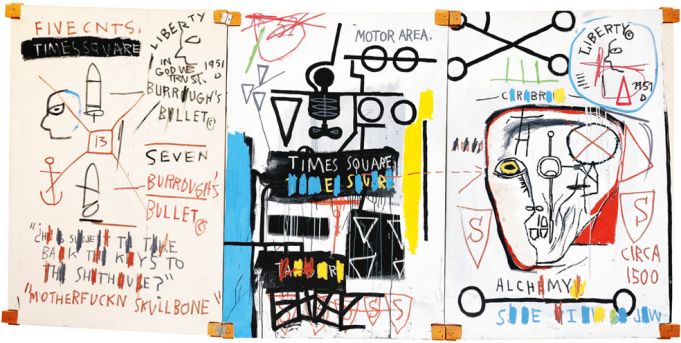
Mercurio describes the Rome exhibition as a “retrospective”, spanning the entire range of Basquiat's colourful but all-too-short career. Running in chronological order, the show charts Basquiat's meteoric rise to fame, from spray-painting epigrams on the streets of Lower Manhattan in the late 1970s to being recognised by the upper echelons of New York's art market within just a few years.
The intriguing spaces of Chiostro del Bramante, which also held a Basquiat show in 2002, are filled with an explosion of wildly-contrasting colours. However it is only on closer inspection that the social message behind Basquiat's many-layered works becomes clear.
From verse to voodoo
The mixed-media paintings and assemblages on display demonstrate the artist's heady mix of primitivism, abstraction and figuration, while his contextual integration of words – with scribbly echoes of Rome-based American artist Cy Twombly – veers from verse to voodoo, and includes a sprinkling of parole italiane for good measure. The exhibition also focuses on themes dear to Basquiat's heart: celebrating his Afro-American roots, an incessant search for identity, his desperate need for recognition and fame.
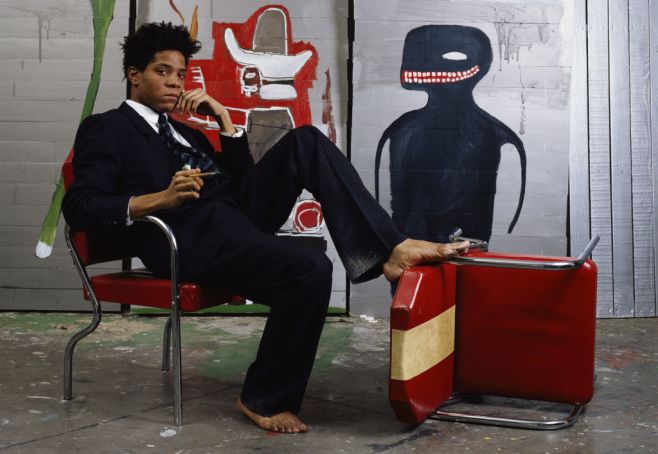
Despite his lack of formal education, Basquiat was well-read in English, Spanish and French, and was insatiably inquisitive. The artist peppered his paintings with erudite literary references, employing “words like brushstrokes” to attack repressive power structures, social inequality and racism.
Early days
Born in Brooklyn in 1960 to a Haitian father and Puerto Rican mother, Basquiat was painting, drawing and scrawling from an early age. As a teenager he skipped school to spray graffiti in downtown Manhattan with his friend Al Diaz. Comprising short cryptic aphorisms, the tags appeared for several years from 1977 under the name SAMO©, derived from “Same Old Shit”, a high-school reference to marijuana. However, to focus on his own work, Basquait killed off the graffiti duo in early 1980, announcing its demise by painting “SAMO© IS DEAD” on Manhattan walls and trains.
Many of his works at the Chiostro are large-scale and striking such as Untitled (Yellow Tar and Feathers), painted in Los Angeles for the Larry Gagosian Gallery in 1982. With its deep yellows, matchstick men and glued-on eiderdown, at first glance there is a childlike freshness to the work. However the piece is weighed down with allusions to the practice of tarring and feathering.
Racism
Confronting racism is a subject that Basquiat returns to time and again, noting that he “didn't see many black people” depicted in paintings. “I am not a black artist,” he would say: “I am an artist.”

Painted on wooden slats, his disturbing Procession scene comprises four silhouetted figures, with white pupil-less eyes, moving towards a black man holding a skull with outstretched hand. The work conjures up images of African slaves, or perhaps the voodoo of his parents' heritage; even the jazz funerals of New Orleans.
Another topic referenced countless times is anatomy. When Basquiat was seven he suffered a serious car accident while playing on the street, an event that was to have a profound impact on his art for the rest of his life. During the long convalescence his mother brought him the celebrated medical textbook Gray's Anatomy to read in hospital. The boy was fascinated by its detailed illustrations, taking inspiration for future works such as the arresting Back of the Neck. An expressionistic x-ray, it centres on a gold spinal column, flanked by two skeletal arms, one flayed, the other pulsating with throbbing red veins. Above the spine is a gold crown, a frequent Basquiat motif, whose myriad interpretations range from blind ambition and “blowing his own trumpet” to pride in the black diaspora and the notion of black nobility.
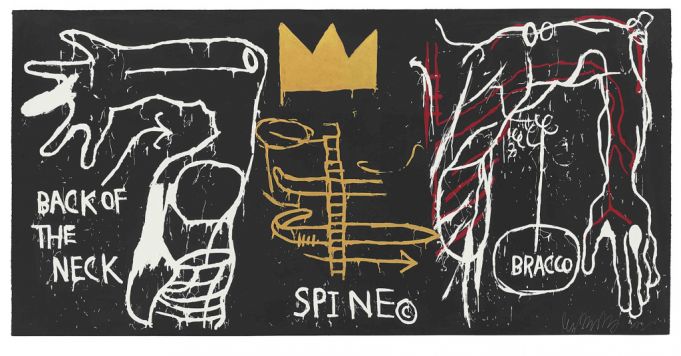
Other eye-catching works in the Rome exhibition include Rusting Red Car in Kuau, a punchy red automobile parked against a deep ultramarine backdrop; the New and Fake pair of paintings in which Leonardo Da Vinci, one of Basquiat's “favourite artists”, is referenced; and Five Fish Species, a triptych tribute to Beat writer William Burroughs. Its oil pastel message “Burrough's Bullet” refers to Burroughs killing his wife in a drunken William Tell-style shooting accident in Mexico.
The show also features an American football helmet covered in human hair; a wonderful pair of wood collages made of painted timber crates – Jazz and Black; and the assemblage Natchez with hardboard cut-outs screwed onto a frame, their overlapping images and words obscuring each other, whitewashed here and there with thick, creamy splodges.
Collaboration with Andy Warhol
The Chiostro del Bramante dedicates a room to Basquait's fruitful collaboration with Pop art supremo Andy Warhol between 1983 and 1985. Once again there is an Italian connection: their initial collaborative works also involved Francesco Clemente who, along with Chia, was a central protagonist in Italy's Transvanguardia movement.
The collaboration idea – suggested by Swiss dealer Bruno Bischofberger – was simple: Warhol would start a painting, Basquait would finish it. Despite Warhol's fame he was in decline artistically, admitting he had “run out of ideas”. Basquiat, on the other hand, was the fresh new star on the New York art scene, whose social circles included popstar and one-time girlfriend Madonna and fellow celebrity artist Keith Haring. Warhol and Basquiat struck up an immediate friendship which blossomed into an almost father-son type bond.
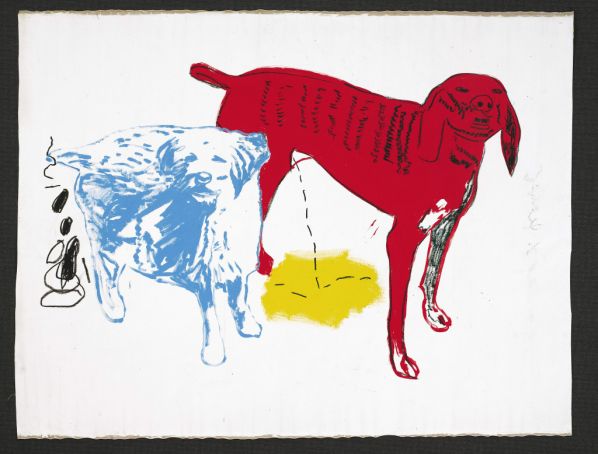
In Thin Lips (1984), Warhol depicts a silhouette portrait of then US president Ronald Reagan, overlaid with economic terms, taking a pot shot at the president's deficit reduction policy. Basquiat completes the work mischievously, writing “Thin Lips” over Reagan's mouth, and adding an empty eye, transforming the portrait into a mask. Likewise in their Untitled (Two Dogs) pair of paintings, Warhol presents a canine duo which Basquiat “finishes” by depicting the dogs urinating and defecating, while almost obliterating the other image in gold paint.
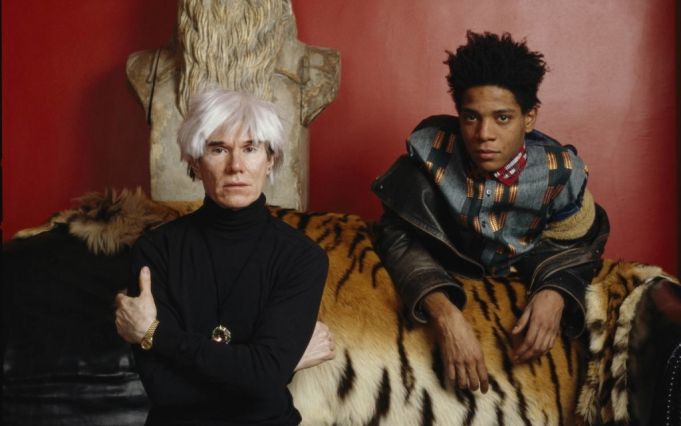
The collaboration turned sour however when critics savaged their work following a show at the Tony Shafrazi gallery in 1985, suggesting that Basquiat was nothing more than Warhol's latest puppet. The reviews had a devastating effect on Basquiat who abruptly ended his friendship with the older artist and fell into a spiral of drug abuse, depression and self-doubt. When Warhol died unexpectedly in February 1987 Basquiat was distraught and bitterly regretted their parting of ways. The following summer, on 12 August, Basquiat died in his art studio from a heroin overdose. He was 27 years old.
The Chiostro del Bramante exhibition showcases Basquiat's dramatic work, conjuring up an atmosphere of Manhattan's once mean streets, with its soundtrack of sirens and subways; it is an edgy tribute to the troubled artist almost three decades after his untimely death.
Andy Devane
The exhibition is on display until 30 July at Chiostro del Bramante, Via Arco della Pace 5, tel. 06916508451, www.chiostrodelbramante.it. This article was published in the May 2017 edition of Wanted in Rome magazine. Cover photo Lizzie Himmel.


















